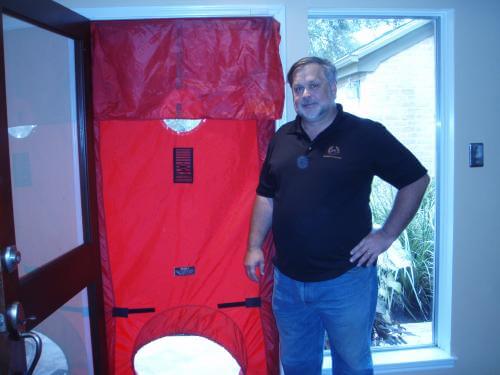Boost your home’s appraisal with insights from energy testing north carolina
Boost your home’s appraisal with insights from energy testing north carolina
Blog Article
The Role of Energy Screening in Attaining an Airtight Option for Your Residential property
Energy screening is necessary for property owners looking for to develop a closed environment. It determines air leakages and inadequacies that can jeopardize power performance. Usual offenders include voids around doors and home windows. Utilizing techniques like blower door tests and thermal imaging, property owners can gain understandings right into their building's vulnerabilities (energy testing). Understanding these findings is important. What actions should be taken once air leaks are recognized? The answers hold the trick to enhanced comfort and financial savings
Understanding Energy Testing and Its Relevance
Energy screening plays a crucial role in reviewing the airtightness of buildings and structures. By determining air leak, this method supplies crucial understandings right into a home's power efficiency, thermal comfort, and general efficiency. Airtight structures lower energy consumption, making sure that home heating and cooling systems operate effectively. This screening procedure typically involves methods such as blower door examinations, which develop a regulated setting to recognize unintended air pathways.Understanding the significance of energy testing extends beyond compliance with building regulations; it fosters a proactive approach to sustainability. Determining air leaks early can result in timely remediation, inevitably boosting interior air top quality and minimizing energy expenses. Furthermore, energy screening adds to the durability of building materials by decreasing dampness buildup and relevant damage. As awareness of ecological effect boosts, energy testing becomes a crucial device for home owners and builders intending for high-performance buildings.
Usual Sources of Air Leaks in Feature
Recognizing typical resources of air leakages is crucial for improving a home's energy performance. These leakages typically occur in numerous areas of a structure, substantially impacting heating & cooling costs. Typical offenders consist of spaces around doors and windows, where seals may wear away gradually. Additionally, electric outlets and switches can develop pathways for air exchange if not properly insulated. Attic rooms and basements are also frequent sources, specifically where walls satisfy the roofing system or the structure. Various other potential leak factors include plumbing infiltrations, venting systems, and the locations surrounding chimneys. In addition, older properties might deal with deteriorated structure products, increasing vulnerability to air seepage. By recognizing these common sources, homeowner can take proactive steps to secure leaks, consequently improving total energy performance and comfort within their rooms. Addressing these concerns is a vital part of establishing a closed option for any kind of home.
Techniques of Energy Testing: Blower Door and Thermal Imaging
Efficient power screening techniques, such as blower door examinations and thermal imaging, play a necessary role in identifying air leakages within a property. The blower door examination includes pressurizing or depressurizing a structure to determine airflow and determine leaks. A calibrated fan is mounted in an outside entrance, and the resulting stress distinction highlights locations of undesirable air seepage. This approach quantifies the overall airtightness of the structure.Thermal imaging enhances blower door examinations by aesthetically identifying temperature level variants on surfaces, revealing surprise air leakages. Infrared cameras record heat loss or gain, permitting accurate recognition of problem locations, such as improperly insulated wall surfaces or gaps around windows and doors. energy testing. Together, these methods supply a thorough analysis of a property's power effectiveness, enabling homeowner to attend to air leaks properly and improve total performance
Advantages of Identifying Air Leaks
Determining air leakages provides substantial advantages for power efficiency and interior comfort. By securing these leaks, buildings can lower energy consumption, bring about lower energy bills and a lowered carbon impact. Furthermore, boosted airtightness contributes to an extra secure indoor environment, boosting general comfort for passengers.
Power Performance Improvements
Identifying air leakages is crucial for enhancing energy effectiveness in buildings. Identifying these leaks enables homeowner to deal with areas where conditioned air runs away or unconditioned air enters, causing significant power cost savings. By sealing voids and fractures, structures can preserve a constant temperature level, reducing the demand on home heating and cooling down systems. This not just lowers energy expenses yet also minimizes the environmental influence related to boosted power usage. In addition, power efficiency improvements contribute to a building's overall sustainability, making it an extra appealing choice for eco-conscious purchasers or occupants. Eventually, focusing on air leakage discovery and remediation aids enhance energy usage, advertises accountable source monitoring, and sustains long-lasting monetary advantages for homeowner.

Improved Indoor Convenience
Dealing with air leakages not just causes energy savings however likewise significantly enhances indoor convenience. When air leakages are effectively identified and secured, temperature level regulation within a building becomes more effective. This causes regular interior temperature levels, removing cool drafts in winter and hot places in summer season. Boosted insulation additionally decreases sound pollution from outdoors, creating a quieter and more relaxed living setting. In addition, boosted air top quality is attained by decreasing the infiltration of outdoor toxins, irritants, and moisture, adding to the total health of passengers. As a result, home owners experience an even more positive atmosphere, cultivating leisure and performance. Eventually, remedying and acknowledging air leaks is essential for achieving ideal interior convenience throughout the year.
How Energy Screening Boosts Convenience and Indoor Air Quality
Power testing plays an important function in enhancing temperature level policy within indoor rooms, ensuring a comfortable and regular atmosphere. By determining and securing air leaks, it also significantly lowers the infiltration of toxins, consequently improving interior air high quality. This twin effect cultivates overall well-being for passengers.
Enhanced Temperature Level Regulation
Reliable temperature level policy substantially contributes to both convenience and indoor air high quality, making it a critical focus for contemporary structure design. Power testing plays a crucial role in accomplishing this law by determining areas where warmth loss or gain occurs, permitting targeted improvements. By ensuring an impermeable building envelope, power testing helps maintain regular interior temperatures, minimizing the requirement for excessive heating or air conditioning. This security boosts occupant convenience, as variations in temperature level can result in discomfort and frustration. In addition, effective temperature control can improve indoor air high quality by reducing the risk of condensation and mold growth, which prosper in irregular temperature level conditions. Power testing is vital for enhancing temperature level administration in commercial and residential homes. Business Minimized Contaminant Infiltration
While many factors add to interior air top quality, lowered toxin infiltration sticks out as a crucial element that energy screening can substantially boost. Power testing identifies air leakages and powerlessness in a building's envelope, which may allow exterior contaminants, allergens, and wetness to enter indoor areas. By sealing these leakages, properties can properly limit air-borne pollutants, leading to a much healthier environment. Boosted airtightness not only boosts comfort but likewise minimizes the worry on heating and cooling down systems, resulting in power savings. In addition, decreased pollutant seepage fosters better overall health for owners, as cleaner air advertises breathing health and lowers allergy signs. Power screening plays a critical duty in creating both a health-conscious and energy-efficient living room.
The Financial Impact of Energy Screening on Utility Expenses

Steps to Take After Energy Screening Outcomes
Once energy testing outcomes remain in, home owners should very carefully review the searchings for to determine the most effective path ahead. The initial step entails recognizing the locations that call for renovation, such as air leakages or insulation shortages. Homeowners ought to then focus on fixings based upon the severity of the concerns and their possible impact on energy efficiency.Next, it is a good idea to speak with specialists who focus on power effectiveness to develop an extensive action plan. This may consist of remedies like securing gaps, adding insulation, or updating home windows and doors.After executing the required changes, a follow-up power examination can identify the go to my site effectiveness of the repairs. Continual tracking is official website likewise vital to ensure that the property keeps its closed status with time. By complying with these steps, home owners can substantially improve their residential or commercial property's power efficiency, causing minimized utility costs and improved convenience.
Frequently Asked Inquiries
Exactly how Often Should I Conduct Power Evaluating on My Residential or commercial property?
The regularity of energy testing must typically be every few years, or complying with significant remodellings. Normal assessments assist identify efficiency enhancements and ensure that the building maintains ideal power performance in time, adapting to changing conditions.
Is Power Testing Necessary for New Constructions?
Power testing is important for new constructions, as it determines potential air leak and insulation problems - energy testing south carolina. Executing these tests warranties energy performance, enhances indoor comfort, and fulfills building codes, eventually causing long-term cost savings
Can I Execute Energy Screening Myself?
Power testing typically calls for specialized tools and proficiency. While some homeowners may attempt fundamental evaluations, expert services guarantee exact results and effective recognition of concerns, inevitably causing much better energy effectiveness and comfort in living spaces.
What Is the Cost of Professional Energy Screening Providers?
The price of expert energy testing services usually ranges from $300 to $1,500, depending upon residential or commercial property intricacy, place, and size. Home owners need to consider possible power cost savings when examining the investment in these services.
How Much Time Do Power Screening Results Usually Last?
Power screening results normally stay valid for one to 3 years, depending upon factors like building adjustments and ecological modifications. Normal updates are recommended to guarantee accuracy and maintain effective energy efficiency standards. Effective power screening approaches, such as blower door tests and thermal imaging, play a necessary role in identifying air leakages within a residential property. Identifying these leakages permits building owners to resolve areas where conditioned air runs away or unconditioned air goes into, leading to substantial energy cost savings. Power screening identifies air leaks and weak points in a building's envelope, which might permit exterior pollutants, allergens, and wetness to go into interior rooms. As homeowners progressively look for navigate to this website to minimize their power expenses, the function of power testing comes to be important in recognizing ineffectiveness and leaks. Home owners ought to after that prioritize repairs based on the intensity of the problems and their potential effect on energy efficiency.Next, it is advisable to consult with experts who specialize in power efficiency to design an extensive activity strategy.
Report this page